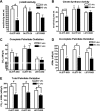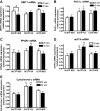Changes in skeletal muscle mitochondria in response to the development of type 2 diabetes or prevention by daily wheel running in hyperphagic OLETF rats
- PMID: 20233940
- PMCID: PMC2886529
- DOI: 10.1152/ajpendo.00703.2009
Changes in skeletal muscle mitochondria in response to the development of type 2 diabetes or prevention by daily wheel running in hyperphagic OLETF rats
Abstract
The temporal changes in skeletal muscle mitochondrial content and lipid metabolism that precede type 2 diabetes are largely unknown. Here we examined skeletal muscle mitochondrial fatty acid oxidation (MitoFAOX) and markers of mitochondrial gene expression and protein content in sedentary 20- and 40-wk-old hyperphagic, obese Otsuka Long-Evans Tokushima fatty (OLETF-SED) rats. Changes in OLETF-SED rats were compared with two groups of rats who maintained insulin sensitivity: age-matched OLETF rats given access to voluntary running wheels (OLETF-EX) and sedentary, nonobese Long-Evans Tokushima Otsuka (LETO-SED) rats. As expected, glucose tolerance tests revealed insulin resistance at 20 wk that progressed to type 2 diabetes at 40 wk in the OLETF-SED, whereas both the OLETF-EX and LETO-SED maintained whole body insulin sensitivity. At 40 wk, complete MitoFAOX (to CO(2)), beta-hydroxyacyl-CoA dehydrogenase activity, and citrate synthase activity did not differ between OLETF-SED and LETO-SED but were significantly (P < 0.05) higher in OLETF-EX compared with OLETF-SED rats. Genes controlling skeletal muscle MitoFAOX (PGC-1alpha, PPARdelta, mtTFA, cytochrome c) were not different between OLETF-SED and LETO-SED at any age. Compared with the OLETF-SED, the OLETF-EX rats had significantly (P < 0.05) higher skeletal muscle PGC-1alpha, cytochrome c, and mtTFA mRNA levels at 20 and 40 wk and PPARdelta at 40 wk; however, protein content for each of these markers did not differ between groups at 40 wk. Limited changes in skeletal muscle mitochondria were observed during the transition from insulin resistance to type 2 diabetes in the hyperphagic OLETF rat. However, diabetes prevention through increased physical activity appears to be mediated in part through maintenance of skeletal muscle mitochondrial function.
Figures





References
-
- Baldwin KM, Klinkerfuss GH, Terjung RL, Mole PA, Holloszy JO. Respiratory capacity of white, red, and intermediate muscle: adaptative response to exercise. Am J Physiol 222: 373–378, 1972 - PubMed
-
- Bass A, Brdiczka D, Eyer P, Hofer S, Pette D. Metabolic differentiation of distinct muscle types at the level of enzymatic organization. Eur J Biochem 10: 198–206, 1969 - PubMed
-
- Benton CR, Han XX, Febbraio M, Graham TE, Bonen A. Inverse relationship between PGC-1α protein expression and triacylglycerol accumulation in rodent skeletal muscle. J Appl Physiol 100: 377–383, 2006 - PubMed
-
- Bonen A, Parolin ML, Steinberg GR, Calles-Escandon J, Tandon NN, Glatz JF, Luiken JJ, Heigenhauser GJ, Dyck DJ. Triacylglycerol accumulation in human obesity and type 2 diabetes is associated with increased rates of skeletal muscle fatty acid transport and increased sarcolemmal FAT/CD36. FASEB J 18: 1144–1146, 2004 - PubMed
-
- Booth FW, Laye MJ, Lees SJ, Rector RS, Thyfault JP. Reduced physical activity and risk of chronic disease: the biology behind the consequences. Eur J Appl Physiol 102: 381–390, 2008 - PubMed
Publication types
MeSH terms
Substances
Grants and funding
LinkOut - more resources
Full Text Sources
Medical
Molecular Biology Databases
Research Materials

